Located at the crossroads to ‘Belt and Road’ connecting the continent and the sea, Southeast Asian countries are at the junction of the world’s important sea routes. As the countries that first launched the initiative of “21st Century Maritime Silk Road”, Southeast Asian countries are the key partners and first priorities in the construction of ‘Belt and Road’ promoted by China. With steady progress, China and Southeast Asian countries have made greater achievements in ‘Belt and Road’ construction based on connectivity. According to the census taken by the subject group, in 2017 the overall performance of Southeast Asian countries successively ranked the first compared to the other regions. Some countries in ASEAN region have achieved good progress.
First, Highly Effective Policy Coordination, China and ASEAN countries have realized the goal of mutual benefit by synergizing China’s initiative of ‘Belt and Road’ with the overall development strategies of Southeast Asian countries. Second, Building of Facilities Connectivity, the building of facilities connectivity is stepping up marked by the export of bullet train, the successful launch of leading infrastructure projects and the realization of the key energy facilities into operation. Third, Updated Version of China-ASEAN Free Trade Zone Agreement, right after the updated version of China-ASEAN Free Trade Zone Agreement officially came into effect, we are speeding up the productivity cooperation focusing on industrial zones and facilitating trade and investment. Fourth, “Finance Guide Principle”, under the guidance of “Finance Guide Principle”, China will continue strengthening the cooperation with Southeast Asian countries and multilateral international finance organizations. The number of projects either in planning for operation or in operation already are both on the rise, which have strongly supported trade, infrastructure construction and the relevant fields in the building of ‘Belt and Road’. Fifth, Strong People-to-People Bond, China and ASEAN countries have formed the strong people-to-people bond by boosting tourist industry in Southeast Asian countries, frequent non-government exchange and overseas students to China so as to lay a solid foundation to guarantee the promotion of the proposal of ‘Belt and Road’ is a success. The general situation is as the following table:

In 2017, Southeast Asian countries were top the list in terms of degree of connectivity with China compared to the other regions along ‘Belt and Road’ route. Southeast Asian countries averaged 63.76(>60 points)in Five Connectivity, nearly ten points higher than the average of 55.25 points scored by the other regions along ‘Belt and Road’ route. Southeast Asian countries, as a whole, were graded connective link type in the degree of connectivity, one grade higher than the other areas along ‘Belt and Road’ route which were graded good link type overall. Among the eleven Southeast Asian countries, four countries were graded smooth link type accounting for 36.4 percent and four countries of connective link type. The countries of relatively higher grade in the degree of connectivity accounted for 72.3 percent of the nations in ASEAN region.

In 2017, Southeast Asian countries scored 12.40 points on average in policy coordination,higher than the average of 10.96 points scored by the other countries along ‘Belt and Road’ route. Southeast Asian countries ranked the second in terms of connective link type region. Among them, the countries of smooth link type were Cambodia and Laos; the countries of connective link type were Thailand, Singapore, Vietnam and Myanmar. Malaysia, the Philippines and Indonesia were of good link type and Brunei and Timor-Leste were of potential link type and weak link type respectively. Cambodia took the first place in policy coordination at the top of Southeast Asian Nations Ranking and the second place in the ranking of all the countries along ‘Belt and Road’ route. In the frame work of ‘Belt and Road’, Cambodia - member of ASEAN and China enjoyed the partnership with the strongest base, the highest degree of mutual-trust and the most abundant cooperative achievements.
First, China and Southeast Asian countries enjoy bilateral high-level visits with the frequency higher than the average level between China and the other countries along ‘Belt and Road’ route. Among Southeast Asian countries, China and Vietnam have the highest level of frequency in bilateral high-level visits. This fact fully demonstrates that ‘China and Vietnam are good neighbors connected by mountains and rivers, good friends witnessing each other’s highs and lows, good comrades having a common goal and good partners with win-win cooperation.’ [1]In 2017, the frequent bilateral high-level visits between China and Vietnam were closely related to the factors including the high degree of China and Vietnam’s involvement in international cooperation mechanism, inter-party diplomacy with socialism characteristics and President Xi’s visit to Vietnam in November. Compared to the previous years, in 2017 we also saw the frequent high-level visits between China and Myanmar and China and the Philippines. These visits have indeed benefited the increase of mutual-trust and the promotion of ‘Belt and Road’ construction. In the second half of 2017, the frequent visits between Chinese leaders and their Singapore counterparts improved Sino-Singapore relationship which had experienced a difficult time, with immediate effect. During his visit to Laos in November, President Xi praised Sino-Laos relationship for its friendly and comprehensive cooperation and hailed it as a typical example for China and her neighboring countries. [2]Second, the leaders of ASEAN countries have a positive attitude towards China’s initiative of ‘Belt and Road’ international cooperation mechanism— ‘Belt and Road’ international summit. The attendance of the leaders of ASEAN countries was the highest at the first session of ‘Belt and Road’ international summit held in May, 2017. Seven leaders out of eleven ASEAN countries were present at the summit. They were President Joko Widodo of Indonesia, President Boungnang Vorachith of Laos, President Rodrigo Duterte of the Philippines, President Chen Daguang of Vietnam, Prime Minister Samdech Hun Sen of Cambodia, Prime Minister Dato' Sri Mohd Najib bin Tun Haji Abdul Razak of Malaysia and Senior Minister Aung San Suu Kyi of Myanmar. Regarding the Philippines for example, it scored 5.11 points in political base, ranking the second in ASEAN countries. Credit for the Philippines’ performance went to President Rodrigo Duterte. Since he came into office, Sino-Philippines relationship has improved rapidly. China and the Philippines have had frequent high-level exchange and set aside the South China Sea dispute, which laid a good foundation for ‘Belt and Road’ cooperation.
Situated at China’s neighboring regions, Southeast Asian countries are regarded by China as strategic partners with mutual-trust, mutual-understanding, mutual-benefit and mutual support. China is consistent in the ideal of amity, sincerity, mutual benefit and inclusiveness and firmly supports the friendly cooperation with ASEAN countries. By the end of 2017, China and eleven ASEAN countries had established partnership. The relationship with Thailand, Vietnam, Laos, Cambodia and Myanmar was enhanced to comprehensive strategic cooperative partnership. China and Indonesia have built a comprehensive strategic partnership and China has set up a strategic cooperative partnership with Brunei and a cooperative partnership, in all aspects, with Singapore. In 2017, China and ASEAN countries realized the effective control over the sovereignty disputes. On May 18, 2017, the 14th Session of Sino-ASEAN High-Level Conference was held in Guiyang aiming at implementing ‘Declaration on the Conduct of Parties in the South China Sea’. The conference deliberated and approved the framework of ‘the Code of Conduct in the South China Sea’. On August 5, 2017, the framework of ‘the Code of Conduct in the South China Sea’ was officially approved by the 50th Session of ASEAN-China Prime Minister Meeting held in Manila-capital of the Philippines. In 2017, the situation of the South China Sea remained stable all year round. Through dialogue and cooperation, both sides made great progress in settling the dispute.
First, Strategy Synergy in the framework of ‘Belt and Road’ China and ASEAN - the regional organization has realized complete synergy. In November,2017, ASEAN, for the first time, issued the official document ‘China-ASEAN Joint Statement on Further Deepening Infrastructure Connectivity Cooperation’ to respond to ASEAN’s overall development plan and China’s proposal of ‘Belt and Road’ synergy at the 31st Session of ASEAN Summit and Related Summits held in Manila. ASEAN promised to synergize ‘Master Plan on ASEAN Connectivity 2025’ with China’s initiative of ‘Belt and Road’ in order to realize further connectivity between China and ASEAN countries. At the summit, ASEAN announced the draft ‘China-ASEAN Strategic Partnership Vision 2030’ so as to enhance ‘2+7’ cooperation framework to ‘3+X’ cooperation framework. Second, National Development Strategy Synergy China proposed to closely synergize ‘Belt and Road’ with the “Two Corridors & One Ring” Strategy in Vietnam,the “Global Maritime Axis” Strategy in Indonesia and the “Rectangular” Strategy in Cambodia. China and ASEAN countries reached a consensus on strategy synergy to work together on “Thailand 4.0” Strategy, “the Philippines Ambition 2040 and “Construction, Construction and Construction” Development Plan”, “Brunei 2035 Vision” Development Strategy and “Laos Changing Landlocked Country into Land Linked Country” Strategy.
By the end of 2017, China and Malaysia, Singapore, Cambodia, Laos and Thailand signed ‘Memorandum of Understanding on Joint Promotion of Silk Road Economic Belt and 21st Century Maritime Silk Road Cooperation’. During President Xi’s visit to Vietnam in November, China and Vietnam signed a document on joint implementation of ‘Belt and Road’ and ‘Two Corridors & One Ring’ Strategy. In addition, the heads of the government of the Philippines, Myanmar, Indonesia, Brunei and Timor-Leste officially supported China’s proposal of ‘Belt and Road’.
In 2017, China and ASEAN countries saw big progress in policy coordination scoring 0.76 (Full Point is 1) with 30 percent up comparing to 0.53 in the previous year. [3]This fact indicates that the implementation and promotion of the initiative of ‘Belt and Road’ has played an important role in helping Sino-ASEAN relationship develop further.
The details are as the following Figure:
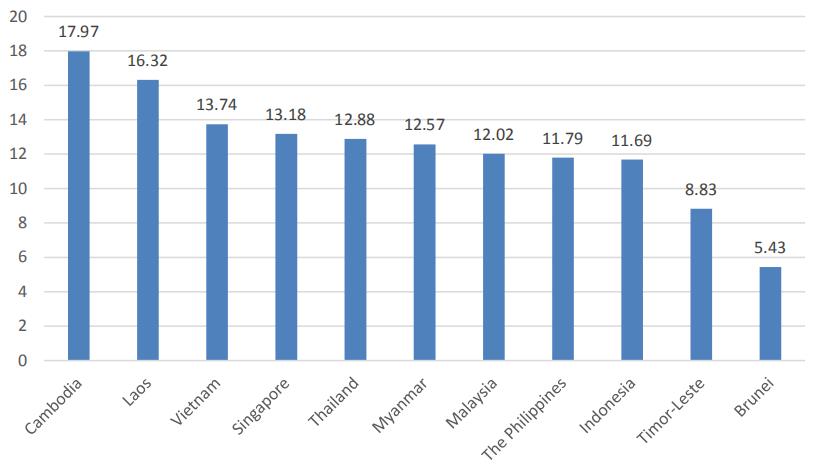
Facilities connectivity is one pillar of the initiative of ‘Belt and Road’. In nearly five years’ construction, ASEAN countries have achieved great progress in facilities connectivity. In 2017, Eleven ASEAN countries were of potential link type in facilities connectivity scoring 9.87 points on average, higher than the overall average of 9.71 points scored by the other countries along ‘Belt and Road’ route. Among them, Cambodia, Singapore, Malaysia, Vietnam and Thailand were of good link type. Laos and Timor-Leste were of weak link type. Cambodia leaped to the first spot of ASEAN countries in facilities connectivity. Furthermore, facilities connectivity in the field of energy was far ahead. On April 10, 2017, in the presence of President Xi Jinping and Myanmar’s President Htin Kyaw, ‘China-Myanmar Crude Oil Pipeline Transport Agreement’ was signed by the two countries. This project is officially in operation transporting 200 thousand barrels of crude oil per day.
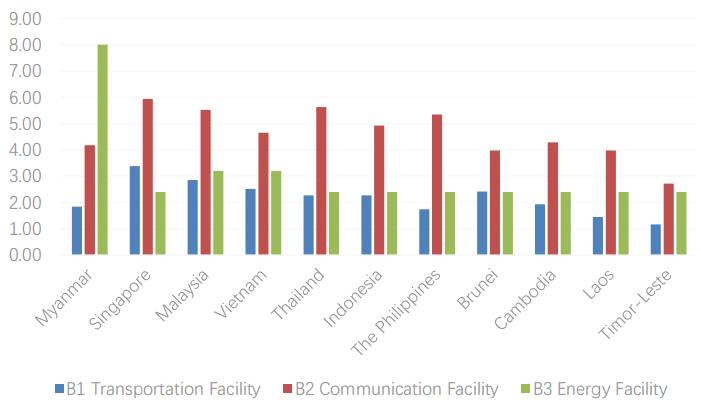
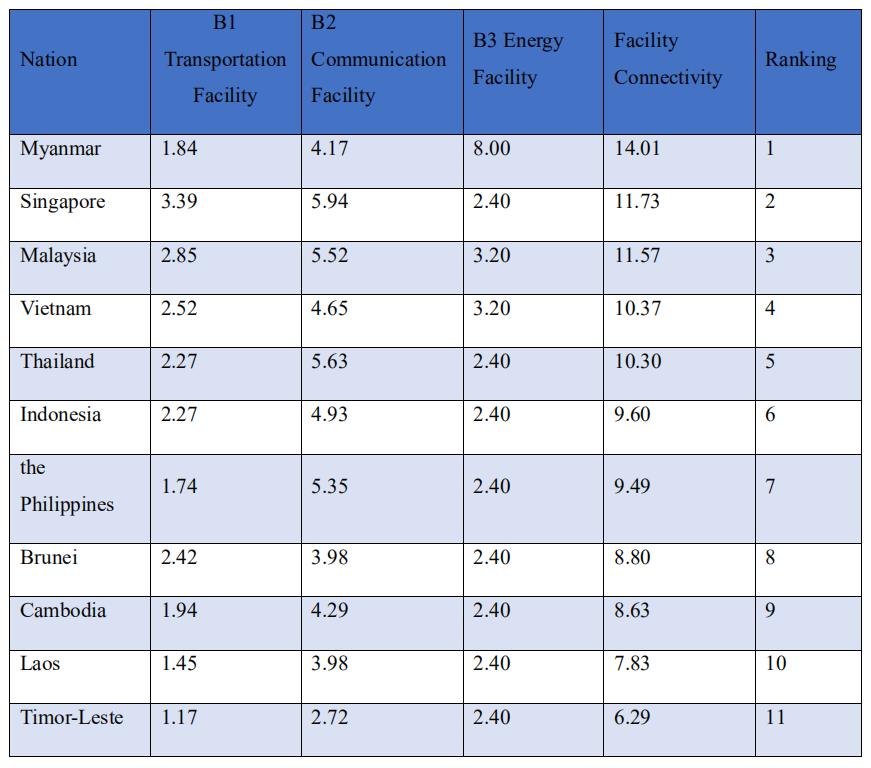
Singapore has the highest overall level of infrastructure in Southeast Asian region, followed by Malaysia, Brunei and Thailand. Laos and Timor-Leste are further down the list. This index is closely connected to the degree of the development of a country. To demonstrate ‘Five Connectivity’ index system based on the frame work of ‘Belt and Road’, the service range of China-Europe Railway Express is one of third-level indicators. ASEAN countries are not along the route of Eurasian railway. Therefore, they have no score in this index, which produces a certain effect in the results in the aspect of transportation facility of ASEAN countries. If Trans-Asian Railway is linked with Eurasian Railway popularizing railway transportation in Asian and European continents and realizing ocean-rail transportation service in the future, the overall level of facility connectivity in Southeast Asian region will surely go up.
The year 2017 is a great for Southeast Asian countries in the construction of facility connectivity especially in railway building. That year, the construction of the Sino-Laos Railway and the Sino-Thailand Railway started successively. The Jakarta-Bandung Express was under construction. The construction of Sino-Laos Railway officially started at the end of 2016 and by the end of October, 2017, this project had already had 207 places under construction including 50 tunnels, 23 large and medium-sized bridges and 96 culverts. To the north, the Sino-Laos Railway would connect to the Mohan Railway-- the recently built railway link in Yunnan Province, China. To the south, it would connect to the railway links in Thailand, Malaysia and other countries. On completion of the project, the Sino-Laos Railway would become an important link of the overland transportation between China and ASEAN countries4. Laos would change from a landlocked country into a ‘Landbridge’ in Southeast Asian region. It would promote the development and enhancement of the regional economics in Laos and the whole Lancang-Mekong area. On September 4, 2017, President Xi Jinping and Thailand’s Prime Minister Prayuth Chan-ocha signed the document relating to railway construction. On December 21, the first-stage of the Sino-Thailand Railway Cooperation Project was officially launched. It is the first standard gauge railway express in Thailand. The first-stage of the project is 253 kilometers in length and the highest speed designed is 250 kilometers per hour. In the blueprint, the second-stage of the project would connect to the Sino-Laos railway, which would form a large corridor between Kunming and Bangkok. The construction of the Sino-Thailand Railway, the Sino-Laos Railway and the Jakarta-Bandung Express makes it clear that the proposal of ‘Belt and Road’ helps ASEAN countries link together through railways towards Eurasia in order to realize real connectivity.
The bilateral communication technology remains at the relatively high level with the score of 4.65 on average between China and Southeast Asian countries. The development level of a few countries hinders the popularity rate of Internet usage and the level of bilateral communication infrastructure. In the past few years, Chinese enterprises have actively participated in the construction of communication facility connectivity in Southeast Asian countries. In 2017, China Telecom in associate with its local business partners, set up a consortium which won the bid and became the third telecom company in the Philippines.
Myanmar is far ahead of the other Southeast Asian countries in terms of the degree of energy facility connectivity. It scored 8 points, much higher than the average level of 3.05 points of this region. Myanmar and China have realized connectivity in the construction of oil and gas pipe line and a power grid. Two-way power trade can be achieved through the power grids connecting the two countries. By the end of 2016, China Southern Power Grid Company Limited had imported as much as 13.9 billion kilowatt-hours of electricity from Myanmar. In addition, both countries are stepping up the construction of electricity infrastructure. On November 10, 2017, the opening ceremony was successfully held at Rybo Transformer Substation to celebrate the launch of 230 kilo-volt main power grid connection and electricity transmission between State Grid Corporation of China and North Kachin, Myanmar. The completion of this project would realize ‘North-to-South’ electricity transmission and ease the electricity shortage in the southern part of Myanmar. On October 24, 2017, the Chinese ambassador to Myanmar held an opening ceremony in Naypyidaw for the Chinese team, led by China Southern Power Grid Cooperation Ltd., working at Sino-Myanmar power grid interconnection project. This event symbolizes the official start of the project. It laid the foundation of 500 kilo-volt Sino-Myanmar power grid connectivity project.
China-Myanmar Crude Oil Pipeline Transport Project consisting of crude oil pipeline and gas pipeline is the fourth energy import channel of China, followed by Central Asia Oil and Gas Pipeline and the Sino-Russia Crude Oil Pipeline and Marine Channel. As a cooperation project, jointly built by China and Myanmar, along ‘Belt and Road’ route, China-Myanmar Oil and Gas Pipeline are regarded as an international model of mutual-benefit and win-win cooperation. China-Myanmar Oil and Gas Pipeline started operation in July 2013 and has transported 14 billion cubic meters of gas to China up to date. [4]On April 10, 2017, in the presence of President Xi Jinping and Myanmar’s President, ‘China-Myanmar Crude Oil Pipeline Transport Agreement’ was signed. On the same day, the long-delayed China-Myanmar crude oil pipeline was formally put into operation with the transport volume of 200 thousand barrels a day. The operation of the pipeline symbolizes that China and Myanmar entered a new stage of cooperation in the field of energy. Electricity Transmission Capacity: China and the countries in Lancang-Mekong area are connected by mountains, rivers and a power grid. As a leading operation team from the Chinese side in Greater Mekong Sub-region, China Southern Power Grid Cooperation Ltd. is active in pushing ahead with power grid connectivity and power cooperation in neighboring regions. Through the circuits of 12 routes over 110 kV, China Southern Power Grid Cooperation Ltd. realized power grid connectivity with Vietnam, Laos and Myanmar. By the end of 2017, electricity power trading had accumulated to 51.65 billion kilowatt-hours. Invested by China Southern Power Grid Cooperation Ltd., the first stage of BOT project--Vietnam Yongxin Coal-Fired Power Plant and Laos’ Nam Tha 1 Hydropower Station Project had been 90 percent and 94 percent completed respectively. The two projects are on the list of ‘Belt and Road’ important exemplary project.
ASEAN is one of the world’s most free trade regions and the countries in this region are the most important trade partners of China. Owing to the natural close ties in economics, China and ASEAN have established the world’s third largest free trade zone, boasting the largest populations in the world. The degree of unimpeded trade in Southeast Asian countries ranks first compared to the other areas. In terms of unimpeded trade, ASEAN is of smooth link type and the only region that reaches the grade. The seven countries consisting of Singapore, Malaysia, Vietnam, the Philippines, Thailand, Cambodia and Indonesia are of smooth link type; Laos is of connective link type; Myanmar and Timor-Leste are of good link type; Brunei is the only country of potential link type. The overall level of this region remains high.
Singapore, Malaysia and Thailand boast the best trade environment, especially the investment environment in Singapore keeps relatively high level with full marks. Myanmar was graded low in trade environment, scoring 0.59, compared to the other ASEAN countries; Myanmar needs to improve in the aspects of business environment, trade barrier and investment barrier which are down the list. The overall degree of unimpeded investment in this region is of high grade with little differences. The fact fully indicates that the China-ASEAN free trade zone enhancement is the driving force behind the increase of trade facilitation and trade volume. Malaysia and Singapore scored relatively high in productivity cooperation which indicates China’s strength in project contracting and labor service in ASEAN countries. As regional powers, Indonesia and Thailand need to improve in this aspect.

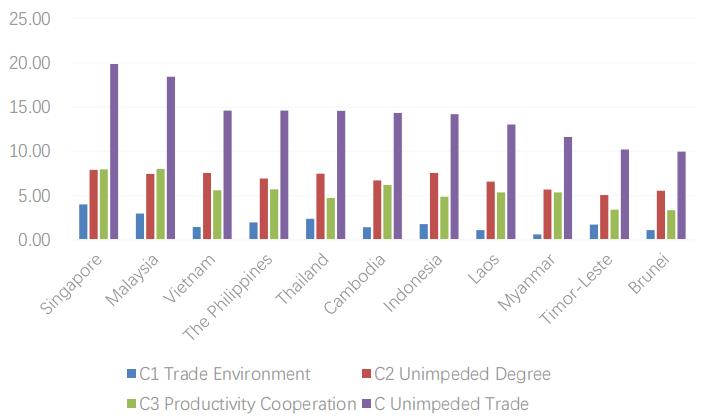
In 2017, China-ASEAN import and export trade volume totalled USD 514.82 billion, up 13.8 percent year -on-year. It is the first time for China and ASEAN countries to completely enhance the China-ASEAN free trade zone in 2017. The practical and efficient approach has stepped up the pace of the integration of the regional economy in this area. China and ASEAN make full advantage of ASEAN’s bigger market, simplifying trade conditions and better investment environment, to largely increase economy and trade exchange between the two sides and efficiently boost the economic development of all the countries. At the first half of 2018, the trade volume between China and ASEAN increased by 20.2 percent compared to the same period of last year, surpassing 3.4 percent over the average growth rate of Chinese foreign trade. Moreover, the trade deficit between China and ASEAN is gradually narrowing with the noticeable tendency of trade balance. In addition, China-ASEAN import and export volume was at high growth rate in 2017. The growth rate of Brunei, Laos, Vietnam and Cambodia was above 20 percent: Brunei saw the highest growth rate of 36 percent. (Table 11-5 for reference)
In the aspect of investment, Chinese investment into ten ASEAN countries reached USD 9.47 billion in 2017. Among them, Singapore, Malaysia, Laos and Indonesia were at the top, getting investments of 3.19 billion, 1.46 billion,1.39 billion and 1.09 billion in US dollars, respectively. China is the largest investment country to Cambodia, Laos and Myanmar. Singapore is the largest investment country to China with USD 4.76 billion, accounting for 93.7 percent of total ASEAN investment to China.

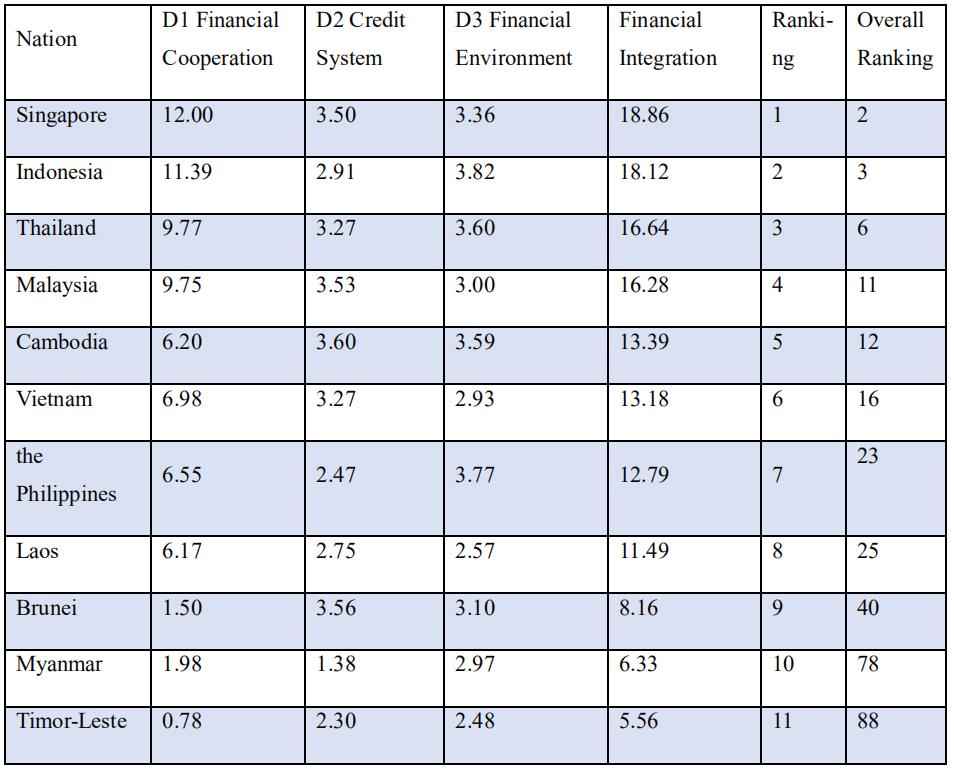
ASEAN countries have the highest level of financial integration compared to the other areas along ‘Belt and Road’ route. They are of the connective link type, scoring 12.50 points on average, two levels higher than the potential link type. However, the degree of financial integration in this region varies from country to country with much difference and obvious gap. Singapore, Indonesia, Thailand and Malaysia are of smooth link type; Cambodia, Vietnam and the Philippines are of connective link type; Myanmar and Timor-Leste are of the weak link type. The countries of good link type account for 72.7 percent. Singapore, Indonesia and Thailand are ranked top ten in 94 countries along ‘Belt and Road’ route. However, Myanmar is ranked 78th and Timor-Leste 88th --sixth from the bottom.

In the aspect of financial cooperation, ASEAN countries have the highest degree of RMB internationalization compared to other overseas areas. China and Singapore, Malaysia, Thailand and Indonesia have either signed or would renew the agreements on currency exchange. China has started overseas RMB settlement services in Singapore, Bangkok and Kuala Lumpur. As a pillar of RMB internationalization, Singapore is the world’s second largest offshore RMB center. The direct exchange between RMB and the Philippine peso is already well underway. The e-pay with Chinese characteristics swept in the Southeast Asian region in 2017. Alipay has already started services in Singapore, Malaysia, Thailand, the Philippines, Indonesia, Cambodia, Laos, Myanmar and Vietnam. It has widely been used by the businesses in Southeast Asian countries, especially in areas with many Chinese tourists. The development level of financial cooperation in ASEAN region is, on average, relatively high. The average score is 6.67 points with two extremes. Myanmar, Brunei and Timor-Leste scored below 2 points, sometimes even below 1 point. There is great room for further development in financial cooperation. Neither currency exchange agreements have been signed between Bank of China and Myanmar, Brunei and Timor-Leste, nor ‘Memorandum of understanding on Bilateral Supervision Cooperation’ between China Banking Regulatory Commission and the three countries mentioned above.
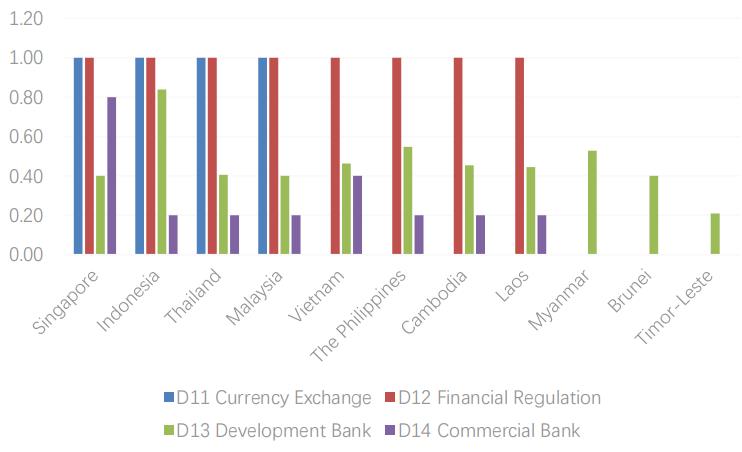
With regard to banking system cooperation, the member countries of ASEAN joined The Asian Infrastructure Investment Bank, which is an important source of funding to guarantee the construction of infrastructure in the Southeast Asian region. In 2017, AIIB approved the Philippines’ Manila Floor Control Project providing USD 207.6 million financing. It also granted a loan of USD 125 million to Indonesia for hydropower equipment upgrading and dam maintenance. Besides, it also provided a loan of USD 100 million to Indonesia Regional Infrastructure Development Foundation Project for transforming slums in Indonesia and building low-rent housing. [5]The Chinese government has set up ‘Silk Road Foundation’, with the investment of USD 40 billion, especially for the construction of key infrastructure and connectivity. The foundation has played an important role in financing ‘Belt and Road’ construction; to ‘Silk Road Foundation’, ASEAN region is an important investment area. Silk Road Foundation provides financing support for strengthening ASEAN infrastructure construction. In 2017, ‘Silk Road Foundation’ joined ‘Asian Emerging Market Fund’, which is an independent investment platform, organized by the third party under IFC. It widens the investment fields in ASEAN region rapidly.[6]
Considering the credit system, there is little difference in the degree of credit facilitation of Cambodia, Malaysia, Brunei and Singapore. It indicates that these four countries are at the top tier of credit facilitation. The other countries need to further improve the planning for credit market building, in order to raise the degree of credit facilitation for local businesses.
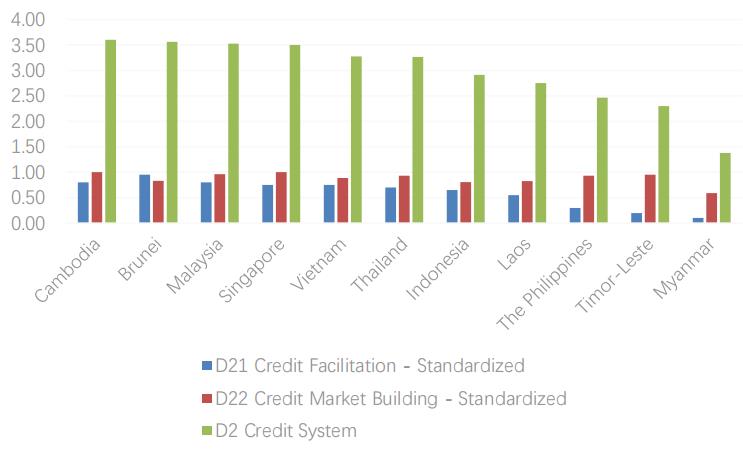
Regarding financial environment, despite the fact that every country has internal and external macroeconomic policies with different focuses, the overall difference of ASEAN countries in the financial environment is not that much, however, it varies greatly in the nation category. On one side, the overall performance of Indonesia, Thailand and Cambodia, in financial integration, is at the top half of the ranking; it is also the same in financial environment ranking. This result was mainly from the relatively small amount of public debt and high stability of currency in 2017 (low inflation and low fluctuation of foreign exchange.) On the other side, Singapore and Malaysia, top of the list in financial integration, are subject to relatively high levels of debt and higher levels of inflation. According to various sources of data, Singapore’s national debt rate is between 110 percent and 113 percent, the 6th highest country compared to the other countries along ‘Belt and Road’ route and the 1st highest in ASEAN region; it is much higher than the average level of 63.5 percent of EU which mainly consists of medium and small-sized economic entity. In 2017, Malaysia had 3.8 percent inflation rate, the highest record since 2008. Therefore, Singapore was graded low in this field. However, based on the estimation of market, Singapore and Malaysia would rise in the ranking in 2018. It is partly because of the hit, by the emerging market exchange rate crisis in 2018, that both Indonesian Rupiah and Thai Baht have experienced relatively large fluctuations; and after the election in Malaysia, a zero consumption tax aims at effectively controlling inflation. Apart from that, Singapore’s budget plan in the new financial year will slightly increase consumption tax, but it will provide enterprises with higher wages, increasing subsidies and corporation tax. In general, these methods are helpful to the income rise of Singapore’s enterprises and improvement of the two countries’ financial environment.
According to the estimated results, ASEAN countries are top of the list in people-to-people bond. They are of smooth link type, which clearly indicates that China and ASEAN region are connected by mountains and rivers and people are bonded closely. Despite a little difference in the nation category, they are, in general, at the top level in people-to-people bond. The index of tourism is dominant, scoring 5.59 points, on average higher than the average of 4.35 points of the countries along ‘Belt and Road’ route. Thailand is ranked 1st place out of 94 countries along ‘Belt and Road’ route, one place up than the previous year. The countries that reached the level of smooth link type are Thailand, Vietnam, Indonesia, Singapore, Malaysia, the Philippines, Cambodia and Laos. Myanmar is of connective link type; Brunei is of good link type, below the average level of the countries along ‘Belt and Road’ route.
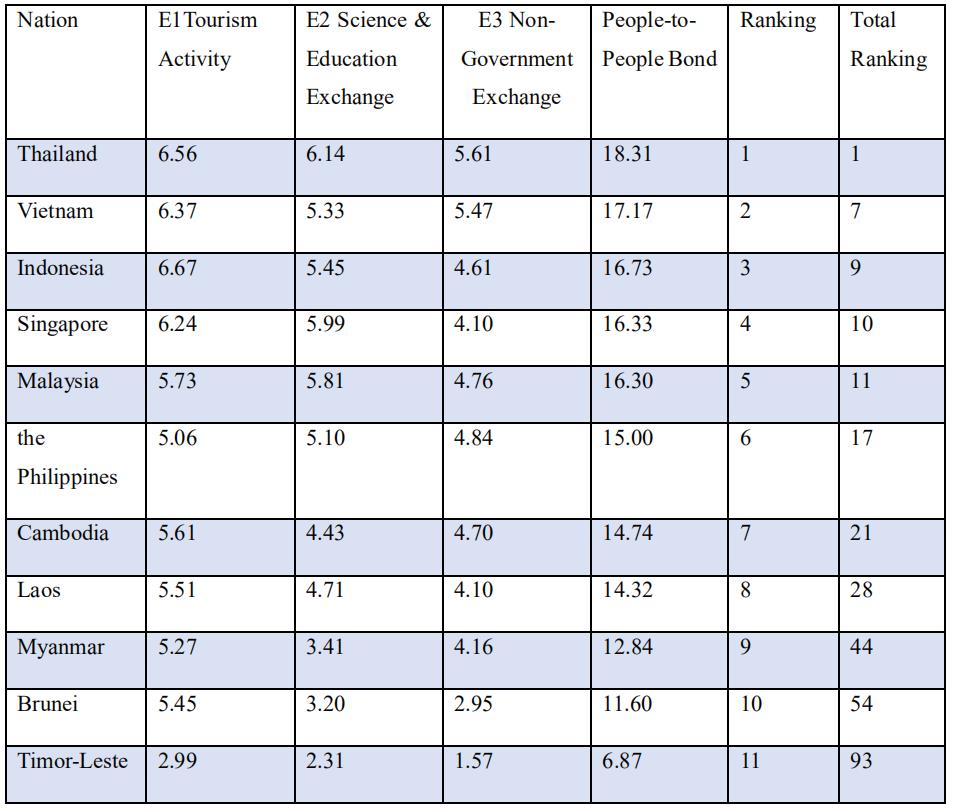
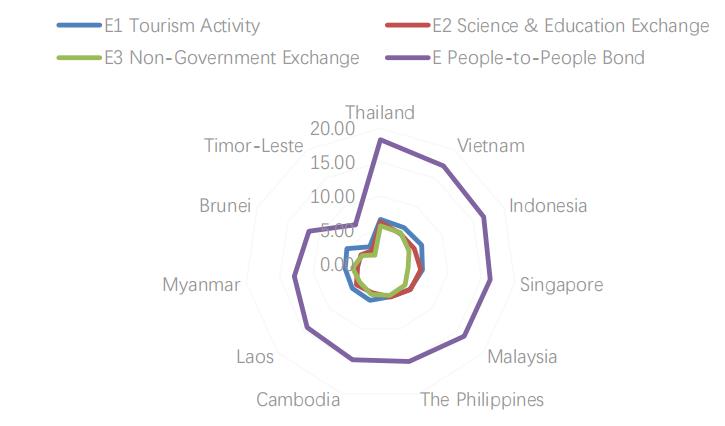
Tourism is one of the cooperation fields with the most common interests, best foundation and greatest potential. China and ASEAN countries are each other’s biggest overseas tourist destination and source of customers. Over 2700 flights come to and from China and ASEAN countries each week. 2017 is China-ASEAN Tourism Cooperation Year. In November, 2017, at China-ASEAN 10+3 Summit, both sides issued ‘China-ASEAN Tourism Cooperation Declaration’. On March 16, 2017, the opening ceremony of China-ASEAN Tourism Cooperation Year was held in Manila, capital of the Philippines, to put one of the important achievements made at China-ASEAN Leaders Meeting into practice. Thailand is the most popular destination for Chinese tourists in ASEAN region. In 2017, over 9.8 million Chinese tourists went to Thailand, 11.97 percent up than the same period of 2016. They brought in an income of more than 520 billion Thai Baht to Thailand (equivalent to 104.7 billion Yuan in RMB) which is 15.78 percent up year-on-year.[7] Vietnam made big progress and took the place of traditional tourist destinations, surpassing Singapore and Malaysia, to the 2nd place in tourism activity. In 2017, the number of Chinese tourists to Vietnam increased rapidly. To Vietnam, China (Mainland China) remained the first largest source of incoming tourists; the number of tourists to Vietnam reached 4 million, 48.6 percent up year-on-year.[8]Vietnam has become China’s 4th largest tourist destination. Conversely, Vietnam has become China’s top ten sources of incoming tourists. In 2017, the number of Chinese tourists to Indonesia reached 2.06 million, 275 percent up from 2013. China remains Indonesia’s largest source of overseas tourists. It is the Philippines’ second largest source of overseas tourists and both sides are endeavoring to increase the number of Chinese tourists to the Philippines to surpass 1 million within the year. The Philippines were up the list regarding Chinese tourist destinations, however, it is less efficient in issuing tourist visas, which affected its overall performance.
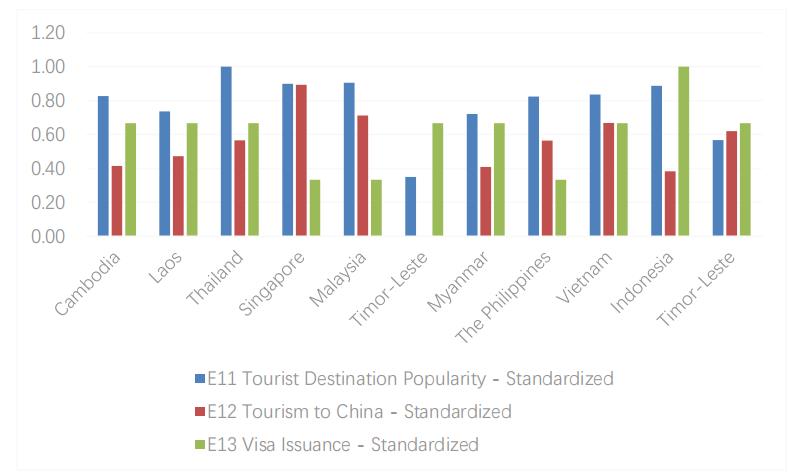
In 2017, the strong increase of overseas students in China indicated that China and ASEAN countries had closer ties in science and technology exchange. Supported by the proposal of ‘Belt and Road’, the Chinese government gave the students from ASEAN countries strong assistance for their study in China. In July 2017, during the 10th session of ‘China-ASEAN Education Exchange Week’, both sides approved ‘Action Plan for China-ASEAN Education Cooperation (2017-2020)’, leading the way to the next stage of education cooperation between the two sides. In the next three years, China would provide ten ASEAN countries with a Chinese government scholarship for no less than 20 thousand students.[9]In 2017, the overseas students from Indonesia surpassed 14 thousand in number. China became Indonesia’s second largest overseas study destination.[10] In 2017, the Chinese government provided scholarships to 103 students from Myanmar to support their study in China.
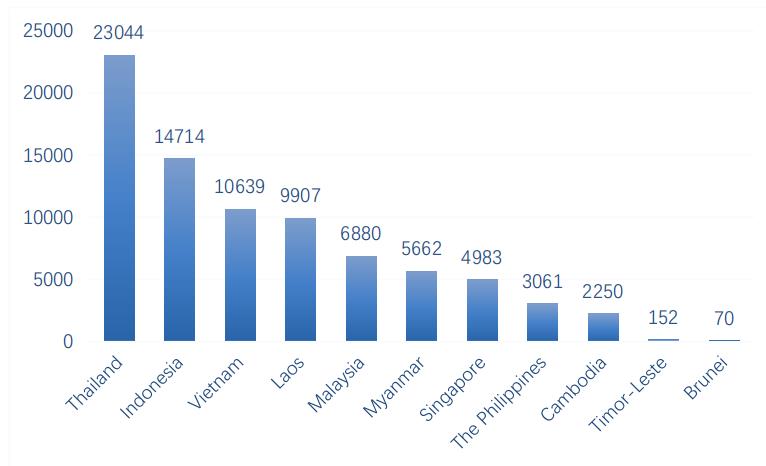
China and ASEAN countries have close ties in non-government exchange. To Chinese Internet surfers, ASEAN countries are popular, thus, there is a high degree of Internet search for this region. Based on the analysis of big data, the popularity of mass communication is at a high level. In recent years, in the frame work of ‘Belt and Road’, the exchange between China’s think tanks and ASEAN countries has been getting more and more frequent. The fact indicates that either bilateral or multilateral two track dialogues play an important role in deepening bilateral exchange and developing bilateral relations. To promote the proposal of ‘Belt and Road’, the booming of regional country studies in China becomes necessary and a direct result. The research on ASEAN countries is prolific in China. Thailand is top of the list in non-government exchange with China compared to other countries in ASEAN region. Therefore, Thailand is the most popular country to Chinese Internet surfers and it is also the country that has set up the most sister cities with China. Vietnam is next to Thailand with the second place in Internet surfers’ attention and popularity of mass communication. The tourism has sprung up between China and Thailand and China and Vietnam. Moreover, the export of Chinese films has gained momentum and their popularity has kept increasing. Thailand’s TV series and cosmetics have had a stable market in China. The popularity of Chinese TV series soars up continuously in Vietnam. Fansub groups have been set up voluntarily to translate Chinese TV series both in China and Vietnam such that it has become an industry. Chinese TV series introduced to Vietnam through the Internet foster a fan base. Many popular TV series are broadcast online, simultaneously, in both China and Vietnam. In addition, the friendliness among people can also be affected by the trend of bilateral relationships. Sensitive international crises can provoke nationalism in the countries involved, which would result in less friendship among people.
Southeast Asia is the important region for China to promote her initiative of ‘Belt and Road’. This region has a great potential for development because it is a close neighbor to China and has a high-level of bilateral connectivity and stable domestic political situation.
The sovereignty disputes between China and some countries in Southeast Asia have a certain impact on mutual trust on both sides, but with the development of ‘Belt and Road’, the disputes are effectively under control. The relatively high level of mutual trust in politics has guaranteed the process of ‘Belt and Road’ in this region. That is to say, Southeast Asian countries are staunch supporters of China’s initiative of ‘Belt and Road’ in international society. The government leaders, who actively participated into China’s ’Belt and Road,’ host diplomacy during which ‘Memorandum of Understanding on Government Cooperation in Joint Construction of Belt and Road’ was signed by the majority of countries. A great demand for China’s financing and market, by efforts to further develop in this region, has fostered the landing of the initiative of ‘Belt and Road’ and made it fruitful. Since the launch of the proposal for ‘Belt and Road’, the building of infrastructure, including transportation and energy, has achieved rapid progress, which has led to a breakthrough in realization of connectivity between China and the Asian continent and China and the European continent. The building of infrastructure, driven by the proposal of ‘Belt and Road’, benefits the countries along the route in Southeast Asia, making them have potential for economic growth in the way of transcending geographical limits and realizing sea-land connectivity. Besides, influenced by the ‘Belt and Road’ policy bonus offered by the Chinese government, the overseas students to China have increased in number, which fosters the strength for friendly and long-term development between China and ASEAN.
Notes:
—————————————————————
FOCUS ON CONTEMPORARY NEEDS.
Should you have any questions, please contact us at public@taiheglobal.org